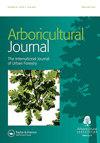Aging mulberry trees (Morus nigra L): The Charterhouse, London, UK
Q3 Agricultural and Biological Sciences
引用次数: 2
Abstract
ABSTRACT Black or Common Mulberry (Morus nigra) was introduced into Britain in the late sixteenth – early seventeenth centuries and has since had limited success as an ornamental and fruit-producing tree. Older specimens survive in a limited number of locations including at The Charterhouse in central London. Four of these trees were investigated with the aid of standard dendrochronological techniques, historic images, including an early postcard and a painting by Edward Ardizzone, and with the application of expert knowledge of the forms and ages of contemporary mulberry trees. Results included the creation of a new ring-width chronology (CH_Mulberry) and dating that suggests the two oldest trees may well have been planted to commemorate either Queen Victoria’s Golden (AD 1887) or Diamond Jubilee (AD 1897). The research represents a first known dendrochronological investigation of the species, highlighting issues associated with sampling “tortuous” growth forms and the poor visibility of sapwood rings, as well as the potential for the use of branch ring-widths to facilitate dendrochronological dating of fruit and other trees.老桑树(Morus nigra L):英国伦敦的Charterhouse
黑桑树(Morus nigra)于16世纪末至17世纪初被引入英国,作为一种观赏树种和果树,收效甚微。更老的标本只在伦敦市中心的查特豪斯等有限的地方存活。其中四棵树通过标准的树木年代学技术、历史图像(包括早期明信片和爱德华·阿迪佐尼的一幅画)以及当代桑树形态和年龄的专业知识进行了调查。结果包括创建了一个新的年轮宽度年表(CH_Mulberry)和年代测定,表明这两棵最古老的树很可能是为了纪念维多利亚女王的金禧年(公元1887年)或钻石禧年(公元1897年)而种植的。这项研究是对该物种进行的第一次已知的树木年代学调查,突出了与采样“曲折”生长形式和边材年轮能见度差有关的问题,以及利用树枝年轮宽度促进水果和其他树木的树木年代学年代测定的潜力。
本文章由计算机程序翻译,如有差异,请以英文原文为准。
求助全文
约1分钟内获得全文
求助全文
来源期刊

Arboricultural Journal
Agricultural and Biological Sciences-Agronomy and Crop Science
CiteScore
2.40
自引率
0.00%
发文量
28
期刊介绍:
The Arboricultural Journal is published and issued free to members* of the Arboricultural Association. It contains valuable technical, research and scientific information about all aspects of arboriculture.
 求助内容:
求助内容: 应助结果提醒方式:
应助结果提醒方式:


